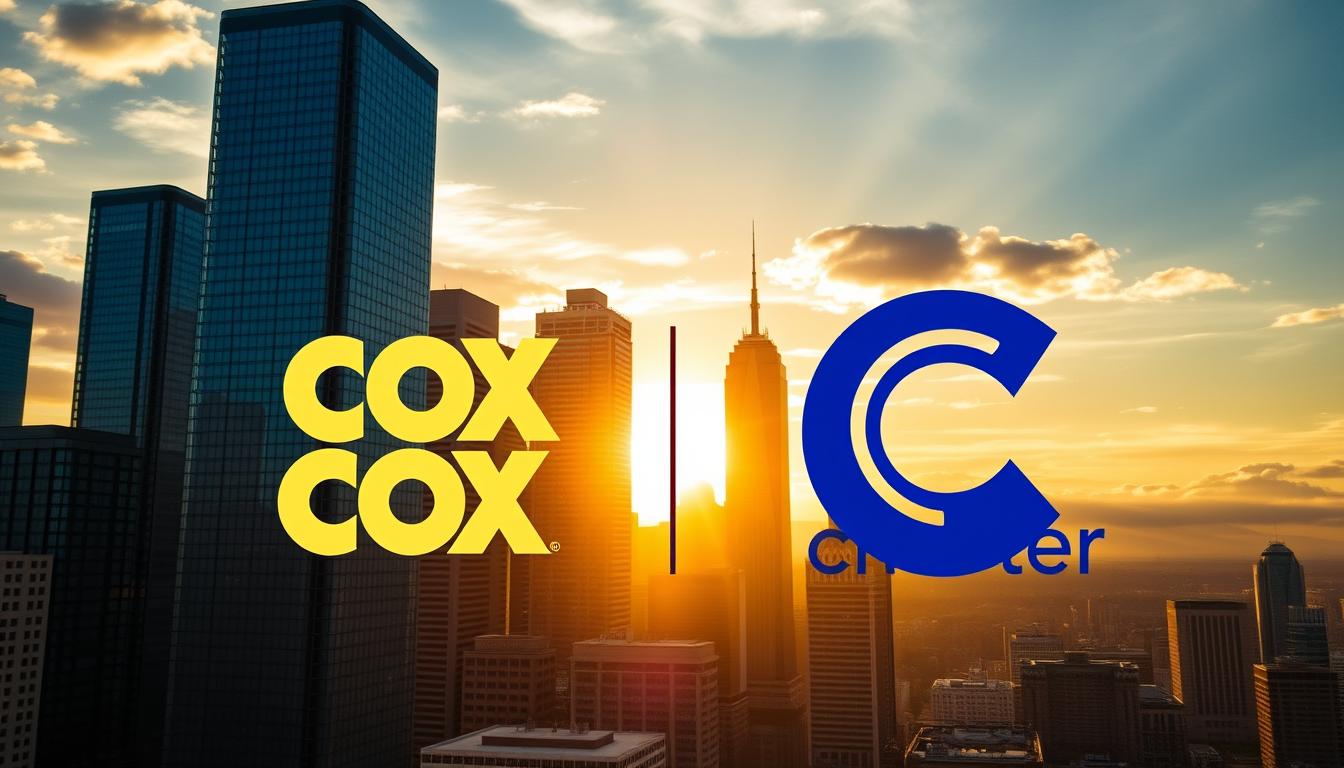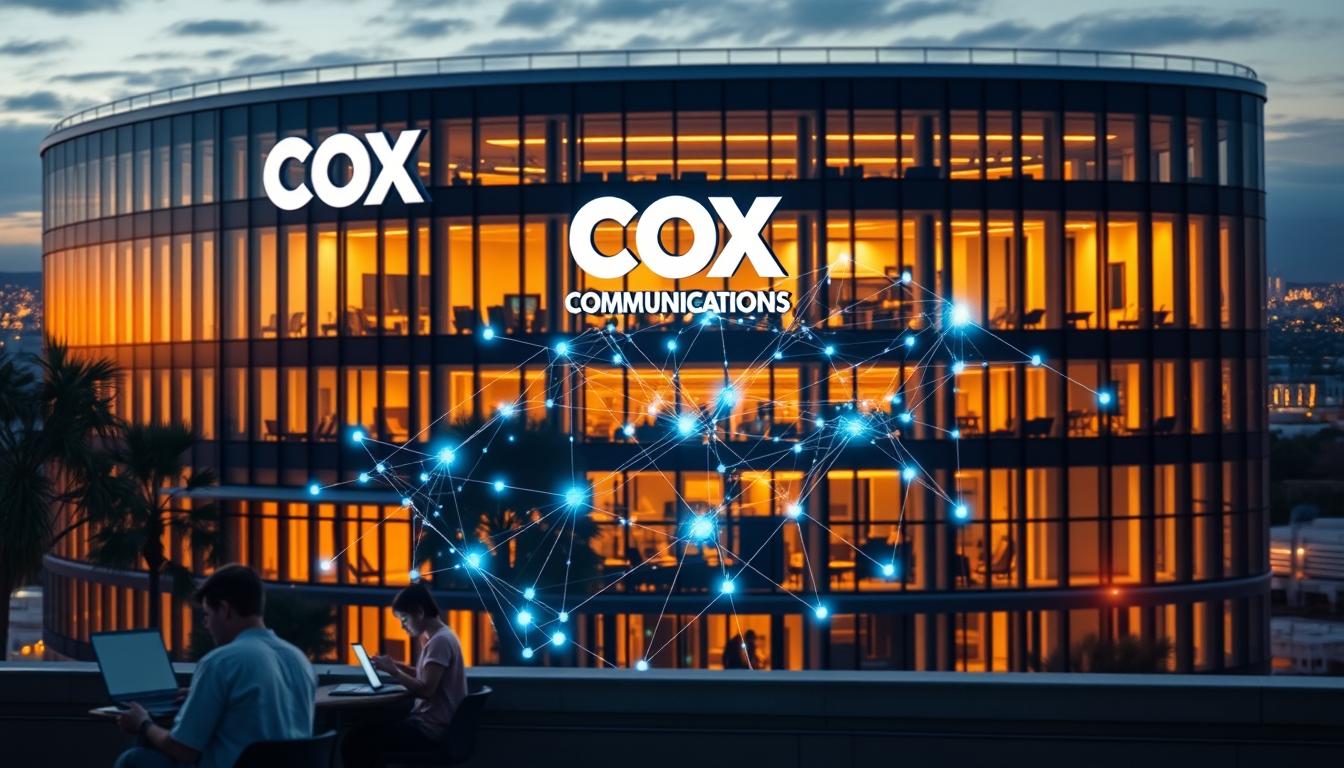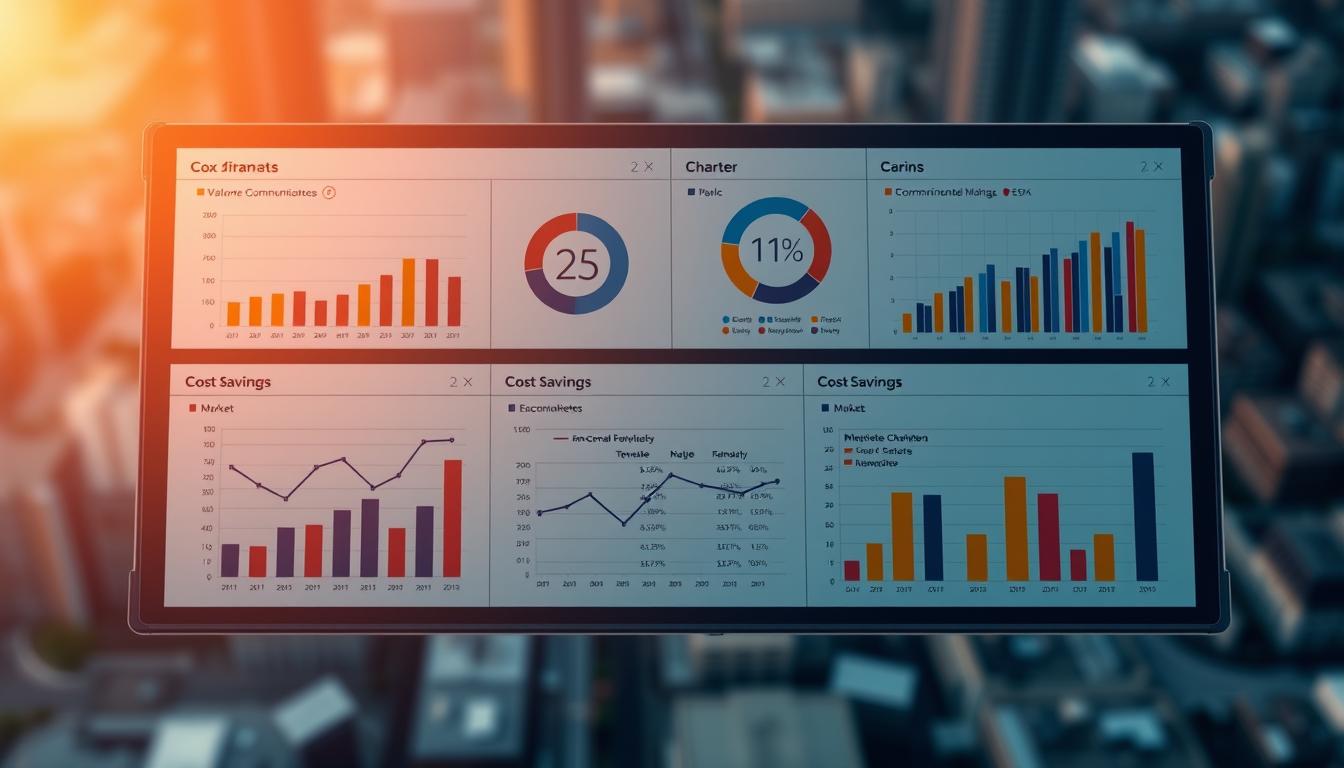

A big change is coming in the telecom world. Cox Communications and Charter are merging in 2025. This will make a huge company in the broadband and cable services market.
The deal is worth $34.5 billion. It’s expected to make the industry more competitive.
This telecom merger is a big step in cable industry consolidation. It could change things for both consumers and providers.
Key Takeaways
- A $34.5 billion merger between Cox Communications and Charter is set for 2025.
- The deal aims to create a more competitive entity in the telecom industry.
- This move is part of the ongoing cable industry consolidation.
- Enhanced competitiveness is expected through the combined resources and infrastructure.
- The merger could significantly impact the broadband and cable services market.
The Announcement of the Cox Communications and Charter Merger
Cox Communications and Charter have announced plans to merge in 2025. This move is expected to change the telecom industry a lot. It will also have a big impact on broadband services.
Key Details of the Merger Proposal
The merger plan is a big deal. It will bring together the resources and customers of both companies. Charter CEO Chris Winfrey is excited, saying it’s “good for America” and will create new jobs.
The deal aims to improve broadband services for everyone. It’s a big step forward for the companies.
| Merger Details | Description |
|---|---|
| Deal Valuation | $45 Billion |
| Expected Outcome | Enhanced Broadband Services |
| Job Impact | Creation of new customer service and sales careers |
Initial Market Reactions
The merger news has mixed reactions. Some investors worry about the deal’s price and regulatory issues. But others see it as a smart move to grow in the telecom industry.
The merger will likely change the telecom world a lot. It could mean better services and more jobs. As the deal moves forward, everyone in the industry will be watching closely.
Background on Cox Communications

Cox Communications is the largest private broadband company in the U.S. It has a long history, starting many decades ago. The company has grown a lot, becoming a key player in the broadband world.
Company History and Growth
Bud Cox founded Cox Communications in 1962. It started with cable TV. Now, it offers high-speed internet, digital phone, and home security too. This growth has helped it serve about 6.5 million customers across the U.S.
Current Market Position and Services
Today, Cox Communications is known for its big broadband network and quality services. It has a strong position in the market because of its wide range of services.
Residential Service Offerings
Cox Communications offers many services for homes, including:
- High-speed internet
- Digital TV
- Home phone
- Home security solutions
These services aim to make life easier and more fun for customers.
Business Solutions Portfolio
For businesses, Cox Communications has a wide range of services, such as:
- Managed IT services
- Cloud solutions
- Business internet
- Voice and data services
These services help businesses work better and stay ahead of the competition.
Charter Communications Profile
Charter Communications is a major player in the US market. It offers cable, broadband, and mobile services. The Spectrum brand is at the heart of its operations.
Spectrum Brand and Market Reach
The Spectrum brand is known for its wide range of services. This includes cable TV, fast internet, and mobile services. By the first quarter, Charter had 30 million broadband customers.
This shows its big market reach. The Spectrum brand is key to Charter’s success. It helps the company stay competitive.
Financial Performance Pre-Merger
Before the merger, Charter’s finances were strong. This was thanks to its varied income sources and smart growth plans.
Revenue Streams Analysis
Charter makes money from several areas:
- Residential broadband services
- Cable TV subscriptions
- Mobile services through Spectrum Mobile
- Business services, including enterprise solutions and commercial internet
This mix of income sources has helped Charter stay financially stable and grow.
Growth Trajectory 2020-2025
From 2020 to 2025, Charter has seen steady growth. This is due to more people wanting fast internet and mobile services. The company has expanded its fiber network and improved its services.
Financial Implications of the Cox Communications Charter Merger 2025

The merger between Cox Communications and Charter in 2025 will change the financial scene in telecom. It has caught the attention of investors, analysts, and industry experts.
Deal Valuation and Structure
The deal’s value and how it’s structured are key. The exact value is still a secret, but it’s expected to be huge. The deal might include cash, stock, and debt to use both companies’ assets.
Key financial aspects of the deal include:
- Deal valuation: Estimated to be in the tens of billions of dollars.
- Payment structure: Likely a combination of cash, stock, and potentially debt.
Expected Financial Synergies
The merger aims to make the new company more profitable. It will save money and make more through new strategies.
Cost-Saving Opportunities
The deal could save about $500 million a year within three years. Savings will come from:
- Operational efficiencies
- Reduced overhead costs
- Streamlined management structures
Revenue Enhancement Strategies
The new company will also make more money through:
- Cross-selling opportunities
- Expanded service offerings
- Enhanced customer retention programs
Here’s a breakdown of the expected financial synergies:
| Category | Year 1 | Year 2 | Year 3 |
|---|---|---|---|
| Cost Savings | $150M | $300M | $500M |
| Revenue Growth | $100M | $250M | $400M |
| Total Synergies | $250M | $550M | $900M |
Regulatory Hurdles and Approval Process

Getting approval for the Cox Communications and Charter merger is a big step. It’s complex and involves many steps and people.
FCC and DOJ Review Requirements
The merger needs approval from important groups like the Federal Communications Commission (FCC) and the Department of Justice (DOJ). The FCC’s review process looks at how the merger affects the telecom world. They check on competition, how it helps consumers, and if services are good.
The DOJ looks at antitrust issues. They see if the merger could make markets too big or hurt competition. Both agencies make sure the merger follows the rules and laws.
Potential Regulatory Concerns
There are a few big concerns for the merger. These include how it might affect market size and protect consumers.
Market Concentration Issues
One big worry is market size. The new company could be too big. This might mean less competition and higher prices for people.
Consumer Protection Considerations
Protecting consumers is also key. Regulators will check if the merger could make services worse, reduce new ideas, or raise prices.
| Regulatory Body | Focus Area | Key Considerations |
|---|---|---|
| FCC | Telecommunications landscape impact | Competition, consumer welfare, service provision |
| DOJ | Antitrust implications | Market concentration, competition harm |
Market Impact and Industry Consolidation

The telecom industry is changing fast. The merger of Cox Communications and Charter in 2025 will change the game. It will make Charter one of the biggest broadband providers in the U.S., changing how the market works.
Competitive Landscape Changes
This merger will make the market more consolidated. With fewer players, there will be more efficiency and better services. The big company will use its size and resources to improve.
The market will change a lot. Other telecom companies will have to adjust. They might consolidate or innovate to stay ahead.
Comparison to Previous Telecom Mergers
Looking at past telecom mergers helps us understand what’s coming. Two big examples are the AT&T/Time Warner and T-Mobile/Sprint mergers.
AT&T/Time Warner Precedent
The AT&T/Time Warner merger in 2018 was big news. It showed how merging telecom and media can be tricky. It raised questions about content distribution and prices.
T-Mobile/Sprint Lessons
The T-Mobile/Sprint merger in 2020 showed benefits of consolidation. It led to better networks and lower prices. The new company could shut down old networks and focus on 5G.
Here’s a comparison of these mergers:
| Merger | Year | Key Outcomes |
|---|---|---|
| AT&T/Time Warner | 2018 | Content distribution changes, pricing impacts |
| T-Mobile/Sprint | 2020 | Improved 5G capabilities, competitive pricing |
Consumer Implications of the Merger
The Cox Communications and Charter merger is coming. This will change broadband and cable services for consumers. People will see new service options and pricing changes.
Potential Service Changes
Cox customers can switch to Spectrum or keep their plans. This makes the change easier for them. Some might get enhanced service quality and expanded channel offerings.
The new company might also add new services. This could make the customer experience better.
- Potential upgrades to existing services
- Introduction of new streaming options
- Enhanced customer support
Pricing Considerations
The merger could change how prices are set. Prices might go up because of less competition. But, the new company might also offer competitive pricing to keep customers.
The final effect on prices depends on many things. These include rules from regulators and the market.
Coverage Expansion Possibilities
The merger could also mean better coverage. The new company might improve infrastructure in areas that need it. This could give consumers better connectivity and reliable services.
Technological Innovation and Infrastructure Development
The merger of Cox Communications and Charter is going to boost tech innovation and infrastructure. This move will combine the best of both companies. It aims to improve network and tech capabilities.
5G and Fiber Expansion Plans
The new company will spend a lot on growing its 5G and fiber networks. This will make mobile coverage better and internet faster and more reliable. It will help both homes and businesses.
| Technology | Current Coverage | Projected Expansion |
|---|---|---|
| 5G | 60% of the country | 85% by 2027 |
| Fiber | 40% of households | 65% by 2028 |
Smart Home and IoT Integration
The merged company will also improve its smart home and IoT services. This will make living more connected and easy.
With smart home devices and IoT, people can control their homes better. It will improve security, entertainment, and energy use.
Workforce and Stakeholder Impact
The Cox Communications and Charter merger is on the horizon. It will have big effects on employees and investors. The merger will change the workforce and stakeholder landscape a lot.
Employment Changes and Corporate Culture
The merger will create new jobs in customer service and sales. This is because the new company wants to grow its market share. But, it might also mean some jobs will be cut as the companies become more efficient. The impact on corporate culture will depend on how the two companies integrate their values and practices.
Shareholder and Investor Perspectives
Shareholders and investors see the merger as a chance for big financial gains. They believe it will make the company stronger and more competitive. Investors will be watching closely to see how the merger unfolds and how it affects the company’s financial performance. The success of the deal will depend on how well the companies work together and plan their strategy.
Conclusion: The Future Telecommunications Landscape
The merger between Cox Communications and Charter in 2025 will change the telecom industry. It will make a leading company in broadband and cable services. This move will bring big changes to the future of telecommunications.
This merger could make the new company stronger and offer better services. With more power, they might invest in new technologies. This will help customers and shape the industry’s future.
The telecom world will see more competition, new tech, and changing customer needs. As the industry grows and changes, companies must keep up. The Cox Communications and Charter merger is a big step in this journey.
FAQ
What is the Cox Communications and Charter merger?
The Cox Communications and Charter merger is a big deal in the telecom world. It was announced in 2025. It aims to create a bigger, more competitive player in the broadband and cable market.
What are the benefits of the Cox Communications and Charter merger?
The merger is expected to bring many benefits. These include creating jobs, improving services, and making the telecom industry more competitive.
What is the valuation of the Cox Communications and Charter merger deal?
The deal’s value is a key part of the merger. The combined company is expected to have a big financial impact in the telecom industry.
How will the merger affect the telecom industry?
The merger will likely change the telecom industry. It could lead to more consolidation and shift the market dynamics.
What are the regulatory hurdles for the Cox Communications and Charter merger?
The merger faces several regulatory challenges. These include reviews by the FCC and DOJ. There are also concerns about market concentration and consumer protection.
How will the merger impact consumers?
The merger might change services, prices, and coverage. It could affect the quality and availability of broadband and cable services for consumers.
What technological innovations can be expected from the merged entity?
The merged company plans to expand its 5G and fiber networks. It aims to integrate smart home and IoT technologies. This will drive innovation in the telecom industry.
How will the merger affect the workforce and stakeholders?
The merger may lead to changes in employment and corporate culture. It could also impact shareholder and investor views. This will affect the company’s leadership and employees.
What is the expected outcome of the Cox Communications and Charter merger?
The merger is expected to make the telecom industry more competitive. It could benefit consumers, employees, and stakeholders. But, it also presents challenges and opportunities for growth.
What are the financial synergies expected from the merger?
The merged entity expects to save costs and increase revenue. This will drive growth and profitability.
How does the Cox Communications and Charter merger compare to previous telecom mergers?
The merger can be compared to others like AT&T/Time Warner and T-Mobile/Sprint. These comparisons offer insights into the merger’s potential outcomes and challenges.
RELATED POSTS
View all


